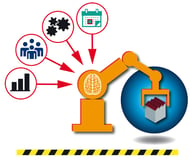Five Supply Chain Analytics Trends to Watch in 2017
Kristin Masters - December 13, 2016

.jpg?width=320&name=blogs_trends_2017b%20(2).jpg) With the advent of advanced analytics and accompanying technology, the supply chain is evolving perhaps more rapidly than ever before. Here's a look at five key trends that illustrate where the industry is heading in the next year, and beyond.
With the advent of advanced analytics and accompanying technology, the supply chain is evolving perhaps more rapidly than ever before. Here's a look at five key trends that illustrate where the industry is heading in the next year, and beyond.
1. Data unification will facilitate visibility across the supply chain.
The supply chain industry has already seen a major evolution in the implementation of data across individual enterprises. This shift has facilitated almost complete supply chain visibility within organizations, resulting in greater efficiency and profitability. But visibility outside the organization remains a significant obstacle. For example, manufacturers don't generally have access to data from their suppliers, or from the third-party shippers they use to transport final products. This lack of visibility makes it significantly more difficult to anticipate complications and plan ahead more effectively.
The next phase of data unification will directly address this challenge. Over the coming years, the industry will continue moving to the end-to-end supply chain management model foundational to Industry 4.0. As tools are developed to standardize data across different channels in real time, entities at every level of the supply chain will have equal access to actionable, accurate data. This will certainly encourage the expedited adoption of analytics by supply chain organizations that are currently lagging behind, and it will also lead to increased profitability through more informed decision making across the manufacturing industry.
2. Supply chain leaders will begin to use Big Data much more effectively.
Every day supply chain enterprises produce and collect massive volumes of data, generated by both devices and humans. And it's not uncommon for business leaders to admit that they're not sure what, exactly, to do with all that information; right now many manufacturing enterprises are collecting Big Data, but not using it. But as the industry moves toward seamless integration of advanced supply chain analytics, it will be crucial to put all that data to work.
Meanwhile, the tools of the manufacturing trade are also steadily evolving. We're moving into the next "phase" of Big Data, where the data is also smart thanks to machine learning. This smart data better enables supply chain leaders to identify business problems using flexible, evidence-based solutions. And because the smart data is available in near real-time, the supply chain can be much more nimble, adjusting to unforeseen changes more efficiently and ultimately increasing profitability.
3. Fundamental best practices in supply chain management will regain priority.
We, manufacturing logistics leaders, have seen plenty of "next big things" in the industry. Modern ERP is a terrific example: following an era of ad hoc software solutions, the supply chain industry eagerly embraced the monolithic — and overly restrictive— software packages of Modern ERP. It's only now, decades later, that the industry is shifting to a Postmodern ERP to get the flexibility and functionality necessary for the supply chain of the 21st century. But the integration of Big Data isn't just the "next big thing." This evolution will certainly be a permanent one, facilitated by machine learning and advanced analytics.
Many supply chain leaders have already learned, however, that these technologies simply amplify any inefficiency or process failure. That's why we're seeing a subtle realignment of priorities in the industry. While rapid technology integration has taken top priority in recent years, now leading supply chain leaders are reasserting the value of good, old fashioned best practices. They're learning how to place equal emphasis on both the fundamentals of supply chain management and the adoption of emerging technologies that make those best practices even more profitable.
4. Procurement specialists will play an increasingly important role.
Global growth means that manufacturing enterprises are constantly seeking ways to reduce costs and maintain competitive pricing. One sometimes-overlooked source of potential savings lies with procurement. But rather than negotiating with suppliers down to the last penny, procurement specialists will play a more integrative role. Beyond building conventional business relationships with suppliers, they'll also be uniquely positioned to enhance collaboration.
As the industy evolves, procurement specialists will harness the power of supply-side data to drive innovation and growth. For example, they may use both performance ratings and community feedback to decide which partners to work with. Or they'll use real-time invoice approval information to help manage cash flow more effectively. To maximize the benefits of procurement, however, the department must be fully integrated with other supply chain functions. This requires a constant focus on end-to-end supply chain strategy and management from the entire organization.
5. Manufacturing enterprises will fully embrace the hybrid supply chain strategy.
Years ago the supply chain "went Lean." This strategy served the industry well, resulting in more efficient and streamlined supply chains. But the industry has essentially outgrown the Lean approach; as the supply chain simultaneously gets more complex and allows for mass customization, it must also become more flexible and interactive. That's why many supply chain leaders have moved to the Agile approach.
Yet this, too, has its limitations. Instead of adopting only one or the other, supply chain leaders are increasingy moving to a hybrid supply chain strategy that draws on both Agile and Lean principles. This approach provides the interactive flexibility necessary in today's manufacturing environment, where real-time data and machine learning enable (and encourage) extremely rapid decision-making. Technology, then, lies at the heart of this analytics trend because it's what enables suppy chain leaders not only to more accurately predict possible complications, but also react to the unplannable more effectively.
Ultimately these trends all highlight the increasingly critical and integrated role of analytics in the supply chain. To fully realize the potential of this data, manufacturing leaders must choose the right technology and people with an eye toward end-to-end supply chain strategy.
LATEST POSTS
- Understand Why Production Planning Needs Specialized Solutions
- Understand Circular Economy in The Manufacturing Industry
- How Can Industry 4.0 IT Integration Be Achieved Smoothly?
- The Significance of Order Sequencing in Discrete Manufacturing
- How to improve your Supply Chain Management: The Power of Control Towers



